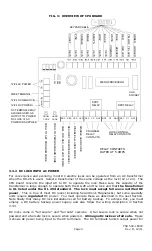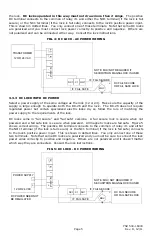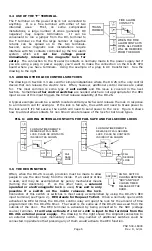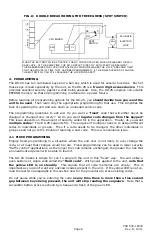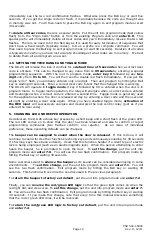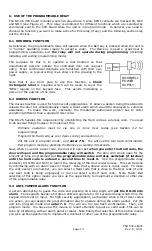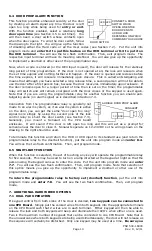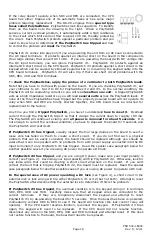
PN# 500-16900
Page 18
Rev. D, 12/11
If the relay doesn’t operate when SRC and REX are connected, the CPU
board has either tripped one of its automatic fuses or has some major
problem requiring replacement. The DK-26 employs three special type
fuses called PolySwitches. PolySwitches look like capacitors. To identify
them on the board note the drawing to the right. When a PolySwitch
senses a current overload problem, it automatically adds a high resistance
to the circuit which limits current flow to about 100 mA, thereby protecting
the circuit. Each PolySwitch protects against a particular problem and you
need to know how to determine if the PolySwitch has tripped and how
to correct the problem and reset the PolySwitch.
PolySwitch #1 comes into play only if you are powering the unit from an AC source connected to
the AC input terminals. It protects against an internal short on the board in the components
(four large diodes) that convert AC to DC. If you are powering the board with DC voltage into
the DC input terminals, you can ignore PolySwitch #1. PolySwitch #2 protects against an
internal DC short circuit on the CPU board. PolySwitch #3 protects against a short circuit in the
keypad which can be caused by skinned keypad wires or mis-wiring the keypad cable into the
CPU board terminals. PolySwitch #3 will also trip if there are short circuit problems with the
SRC, REX, UCD and HCD terminals.
To check the PolySwitches, apply the probes of a voltmeter to both PolySwitch leads.
Note that you have to do this with power on the board. If you are checking PolySwitch #1, set
your voltmeter to AC. Set it to DC for PolySwitches #2 and #3. In the normal condition, the
PolySwitch will be conducting current so you will read less than one volt. A tripped PolySwitch
acts as a high impedance resistor so you will read several volts across the PolySwitch leads. If
none of the three PolySwitches have tripped but the properly powered board will not operate its
relay when SRC and REX are briefly shorted together, the CPU board must be returned for
replacement to the factory.
Any time you find a tripped PolySwitch, you have to understand how to reset it. Overload
current through the PolySwitch trips it so that it clamps the current down to roughly 100 mA.
The PolySwitch will continue to clamp until all power is removed for about 5 seconds. It is
not enough to correct the overload condition; you have to depower the board for 5 seconds and
the PolySwitch will reset itself.
If PolySwitch #1 has tripped, visually inspect the four large diodes on the board to see if a
loose wire has fallen on them to create a short circuit. If you do not find such a physical
problem that can be easily corrected, the board should be replaced although you should be
aware that it can be operated with no problems from a DC power supply connected into the DC
input terminals if only PolySwitch #1 has tripped. Read the special case paragraph below for
another possible cause if you are using AC power to operate a DC lock.
If PolySwitch #2 has tripped, and you are using DC power, make sure your input polarity is
correct (see Figure 2). Reversing your input polarity will trip PolySwitch #2. Otherwise, look for
any loose wires that could be creating a short circuit anywhere on the board. If you can’t
correct the fault that is tripping PolySwitch #2, the board must be replaced. Read the special
case paragraph below for another possible cause if you are using AC power to operate a DC lock.
In the special case of AC power operating a DC lock (see Figure 4), a short circuit in the
external lock or lock wiring will trip either PolySwitch #1 or #2 (but not both). Attempt to reset
the PolySwitch after disconnecting the external lock to determine if this is the problem.
If PolySwitch #3 has tripped, the overload condition is in the keypad wiring or in terminals
SRC, REX, UCD and HCD. Carefully make sure that all keypad wires are connected to the
correct terminals. If they are, temporarily disconnect the keypad and attempt to reset
PolySwitch #3 by de-powering the board for 5 seconds. Once the board has been re-powered,
momentarily connect SRC to REX to see if the board will function (the lock control relay will
operate). If the CPU board resumes function, reconnect the keypad. If PolySwitch #3 trips
again, the keypad will need to be replaced. If the CPU board did not resume function,
disconnect any wires on the SRC, REX, UCD and HCD terminals and attempt reset. If this does
not restore function to the board, the board will need to be replaced.
AC
IN
PS1
PS2
PS3
Summary of Contents for Securitron DK-26
Page 23: ......

